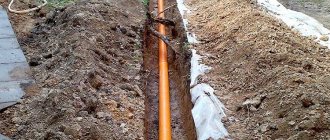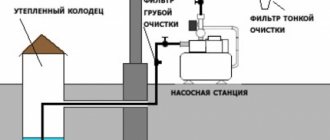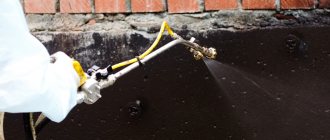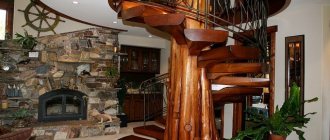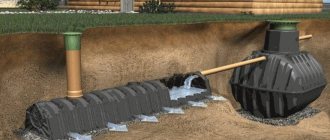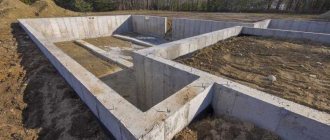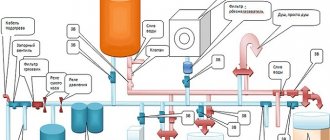A significant number of country houses and dachas are deprived of access to a centralized sewer system, and their owners have to independently solve the problem of removing and disposing of wastewater and organic waste. The only way out of this situation is an autonomous sewer system, the choice of design of which falls entirely on the shoulders of the owners.
It is worth noting that the task of getting rid of sewage waste is one of the main ones, along with water supply and heating, when solving life support issues in individual houses. Therefore, its solution must be approached as responsibly as possible, armed with a solid store of knowledge. Any owner who independently deals with the problem of waste disposal should know how an autonomous sewage system works, study the principles and various options for its construction, the main engineering structures and their distinctive features, advantages and disadvantages.
Rice. 1 Sewer system of a private house
What is an autonomous sewage system and its purpose?
Autonomous sewerage is a system of engineering structures for wastewater treatment using mechanical and biological methods with the disposal of most of the wastewater within the boundaries of the site or in the surrounding area. In this case, waste that cannot be processed or filtered is disposed of and transported off private territory using special equipment.
An autonomous sewage system for a home must solve the following problems:
- Drain gray water and sewage from restrooms away from the home.
- Collect wastewater in any volume (reservoirs, pits, wells).
- Ensure safe accumulation of sewage for people: odors should not penetrate into the home, and contaminated wastewater should not enter underground water sources.
- Dispose of sewage waste in whole or in part on a private plot of land, as well as using special equipment.
- Ensure environmental cleanliness when disposing of wastewater on private property.
Rice. 2 Sewage system with septic tanks made from concrete wells
Cleaning stations
There are two types of this type of structure: with a biological cleaning method and an artificial one. In the first case, only anaerobic and aerobic microorganisms are used, which are forcibly introduced into the system.
For the second type of structure, it is necessary to use additional types of bacteria, as well as ensure a constant flow of air. These models are energy-dependent and involve the use of sediment for pumping and forcing air.
In addition, to ensure the functioning of the system, you should take care of a backup type of power supply, since in the event of a power outage, using the sewerage system is problematic.
It is also worth paying attention to such a disadvantage of artificial treatment stations as the high price, although in terms of efficiency, these models have no equal.
As a rule, the design of treatment stations has 3-4 chambers, which allows for 97-98% wastewater treatment. As a result, the owner of such an object receives process water suitable for use on the farm or for watering plants.
Stations with a biological type of treatment, although inferior in productivity to the previous ones, are also highly efficient and at the same time energy independent. A common positive point for the two types of treatment plants is the possibility of installing them on the site without regard to the groundwater level.
The principle of operation of the autonomous sewage system of a private house and its main components
To understand what an autonomous sewage system means, it is worth considering its main components and the functions they perform. In modern country houses, individual sewer systems include the following components:
Pipeline. Wastewater from kitchen sinks, showers and bathtubs, as well as sanitary fixtures, is sent through gray polyvinyl chloride (PVC) or polypropylene (PP) pipes for internal sewerage to a central riser with a diameter of 110 mm. At the highest point of the sewer system in a private house, a drain pipe is installed, connecting the riser pipe to the ventilation system on the roof.
At the bottom point of the vertical riser, an elbow is mounted to transfer to the horizontal section of the external pipeline made of unplasticized polyvinyl chloride (UPVC) with a diameter of 110 mm, red in color.
An external pipeline with a slope of 20 mm per linear meter is laid underground and directed to a wastewater collection tank.
Storage or treatment tanks. In the simplest form of sewerage, wastewater is collected in storage polymer (concrete) containers and, after filling, is pumped out using a sewer truck.
In some cases, most often in summer cottages and houses in rural areas, sewage waste and gray water from household activities - washing dishes, laundry - are separated. The owners of such houses install a separate outdoor toilet, and contaminated water after use in the household is sent to cesspools.
Rice. 3 Sewerage with septic tank and filtration field with installation dimensions
Related article:
How to install sewerage inside a private house. It may be interesting to read a separate article specifically dedicated to the installation of internal sewer systems, the nuances of laying pipes and connecting engineering equipment!
Almost all autonomous sewer systems of cottage-type country houses are built in such a way that human waste (black water) and gray waste are mixed and sent to septic tanks. There, a gradual separation of solid fractions from liquid occurs as a result of settling and partial decomposition of waste.
The settled, cleaner liquid is sent for further filtration, and the gradually accumulated sludge that has settled to the bottom is pumped out using a sewer truck and disposed of.
If financial resources allow, instead of septic tanks, owners can install deep biological treatment stations (HBT). The stations, through the use of electricity and automation of cleaning, as well as the use of aerobic bacteria, make it possible to obtain 97-99% purified water at the output, which is then simply drained into the ground or used for domestic needs.
Solid sewage waste in a biotreatment plant is converted into harmless sludge with a high content of microelements, which is a good fertilizer for plants. It is used in the garden or disposed of.
Filtration facilities. The degree of wastewater purification after settling in septic tanks does not exceed 70%, so the water needs further purification before being sent deep into the ground. For these purposes, drainage wells or filtration fields are installed. Fine crushed stone and sand are used as filter layers. Passing through them, the wastewater is further purified and does not harm the environment when supplied to the ground.
To ensure a constantly high level of water purification, contaminated crushed stone and sand from wells and filtration fields are regularly changed every 3 to 5 years.
Rice. 4 Types of concrete rings for constructing cesspools
Features of septic tanks
Septic tanks are several chamber tanks connected to each other by overflow pipes. Each chamber has its own cleaning stage. Its basis is fermentation and decomposition by anaerobic bacteria (can live without oxygen), which are contained in waste. The more chambers in the septic tank, the more stages of purification, the purer the outlet water. But it is very rare to obtain more than 50-60% without additional filtration measures.
There is an anti-floating device (“skirt” at the bottom)
Septic tanks are made of plastic, fiberglass, concrete, and very rarely stainless steel. The cameras can be implemented in one housing, or they can be separate. To save money, they often build septic tanks with their own hands. Most often, a septic tank is made from concrete rings, but they are also built from brick or reinforced concrete. Please note that the container must be completely sealed. This is very important when building on your own.
Basic properties
We will understand the operating features of septic tanks. They are:
- At the exit from the septic tank, the wastewater is 50-75% purified. Without additional cleaning, they cannot be dumped onto terrain, into water bodies or used for technical needs (watering the lawn, washing a car, etc.). Therefore, from the outlet of the septic tank, wastewater is supplied to filtration fields/ditches and filtration wells.
- Apart from the presence of drains, the septic tank does not require anything to operate. They are non-volatile and do not need to be populated with bacteria. They are contained in sufficient quantities in the waste that enters the tank. In the septic tank they still actively reproduce, since an optimal environment has been created for them.
One of the septic tank options
- Bacteria living in a septic tank do not need daily feeding. This is an ideal option for temporary residence - for dachas or country houses with a “ragged” activity schedule. They will safely continue their life activities “without feeding” for a long time.
- If the volume is correctly calculated, the septic tank is not afraid of increased volley discharge of wastewater. That is, when flushing the bathtub, you don’t have to worry about flushing the toilet, using the taps, etc.
- Having a large amount of disinfectants and detergents is not very good for bacteria. Since the volume of the chambers is large, it is difficult to cause significant damage to them. When such active chemistry is released, some of the bacteria will die, but most will remain. So one-time powerful chemical influxes will not affect the quality of cleaning.
Internal structure
The main disadvantage of this method of treating wastewater from a private home is the need for additional treatment. Funds are still needed to install additional structures, but without them, the sewage system for a private home will not be correct. Semi-treated wastewater cannot be disposed of on the ground. They will very quickly get into the water and return to your and your neighbors' wells and boreholes. This will not bring you joy and health, and you also have to endure the “gratitude” of your neighbors. So let’s figure out how to treat wastewater after a septic tank.
Where to put the waste
Please note that in combination with a septic tank you must have a tertiary treatment device. Depending on the soil, this may be a filtration well, a filtration ditch or a field (underground or embankment). Only in this case can the cleaning be considered complete. Which type of filter element to use depends on the type of soil and groundwater level. Read about the selection method and the septic tanks themselves here.
One of the ways to treat wastewater after a septic tank is a filtration field
Cesspools
If you are installing an autonomous sewer system with your own hands, one of the simplest and most cost-effective ways to dispose of wastewater is to dig a cesspool.
The structure is a container for collecting gray wastewater located underground, while the toilet is installed outside on the site in any convenient and environmentally safe place. Theoretically, a cesspool can be an ordinary hole with a top lid, dug in the ground, however, due to the erosion of the walls by water, it is not very rational to use this option.
Usually the pit is made with walls made of concrete rings or other materials, large-volume polymer tanks. Special concrete rings with slots in the side walls for drainage are excellent for constructing cesspools.
A pipeline is connected from the house to a hole underground, through which wastewater flows. Liquid is absorbed into the soil through the bottom and side walls in some structures. The volume of the pits is selected based on the amount of wastewater of about 0.5 cubic meters per person per day.
An autonomous sewer system for a summer house or cottage with a cesspool must meet the following distance standards:
- be located no less than 5 m from the house;
- the distance to water intake sources of drinking water should be at least: 20 m for clay soil, 30 m for loam, 50 m for sandy loam;
- the bottom of the pit must be at least 1 meter from the groundwater surface.
Biological treatment
This type of cleaning is perfect for both dachas and cottage communities. It involves the use of sludge with a high content of microorganisms that process all organic substances, that is, household waste, through oxidation.
The system operates on the principle of forced oxygen injection, as a result of which aerobic bacteria multiply and enter the device with waste.
Bacteria oxidize sewage, clearing it of odor and all dirt. The final product resembles flakes and is a clear sludge that does not rot.
Filter fields
Filtration fields are an area of land consisting of trenches in which spray pipes pass. Their work is based on the fact that the soil can be cleaned naturally.
You can build filtering fields yourself and this will save you a little money. However, you will have to call special equipment and purchase material.
Bioponds
Bioponds are a system of reservoirs or one pond, about a meter deep, in which the oxidation of organic substances occurs . Such ponds require measures to remove bottom silt, and in winter the oxygen regime of their operation should be monitored.
cesspool
The easiest way to dig a cesspool without a bottom with your own hands is a popular system option due to its low cost. This design is not suitable, however, for draining fecal matter, since it only processes the liquid part of the waste.
Storage containers
Typically, large-volume polymer containers are used to collect sewage, which are buried underground. A sewer pipeline is connected to them from the house at a slope, through which contaminated liquid is transported.
You can also make a storage tank for a private home yourself from concrete well rings with a lock, placing them on a round slab and covering with a top lid with a hatch. As a result, a sealed concrete well will be obtained, part of the wastewater from which will go into the ground through moisture-absorbing concrete walls.
The storage container is periodically emptied as it is filled, calling a sewer truck for this purpose.
It is rational to use waste collection tanks in summer cottages with periodic presence of people. In this case, the tank will not have to be emptied so often, which is compatible in terms of costs with the installation of more complex and expensive treatment facilities.
Types of biofilters
Filter well
The simplicity of such a biofilter is captivating; it is not intended for large volumes , but can also act as an additional cleaning agent. The service life of such a well depends on the size of the filter area. Not suitable for clay soil.
Underground filtration field
Such fields are suitable for areas where the depth of groundwater is not higher than one and a half meters, and the soil is sandy or sandy loam type. Such a system has many schemes and implementation methods.
Sand and gravel
The choice for places where water hardly passes through the soil, the technology of such a filter is more complex than previous ones. The filter consists of a network of irrigation channels , which are duplicated under a layer of sand with crushed stone intended for filtration. The simplest way to construct such a filter is linear. It can be laid along the fence of the site.
Drainage trench
Despite the similarity with the previous type , this filter differs in that the irrigation and drainage pipes are located in parallel in the pit. They do not have branches and this makes them easier to install. This type is suitable for a small family if the length of the trench exceeds 5 meters.
Filter cassette
It is a shallow, large pool with a crushed stone bottom for filtration . It has a ceiling at the top, which is protected by a layer of waterproofing and insulated with earth. The filter cassette can be used in loamy and clayey areas. Its area at a consumption per cubic meter per day is about 30-35 square meters when used on clay soil.
How to choose a septic tank for a private home, what to consider, how to choose a place for sewerage. Here you will find a diagram for arranging a septic tank made of concrete rings.
Read how to make a septic tank from Eurocubes with your own hands.
Local treatment facilities
In contrast to the previously reviewed methods for disposing of semi-liquid waste, any autonomous sewage system for a country house is designed for their processing and partial cleaning directly on an individual site.
The wastewater is divided into fractions and purified using various methods, while most or almost all of the waste is disposed of in the deep layers of the soil and in external ditches.
Rice. 6 Operating principle of three-chamber septic tanks
Related article:
Sewerage in the country - options, design diagrams and installation. If you need to install a sewer system in your dacha, then in a separate article read about all the possible expensive and cheap options for arranging a sewer system in your dacha. Nuances, types, schemes.
Septic tanks
Septic tanks are engineering structures for mechanical wastewater treatment.
Their operating principle is to settle all wastewater in a number of interconnected containers. In this case, the liquid from the first reservoir, as it accumulates and settles, rises and enters the next container from the purer surface layers. There it further settles, and when the tank is filled, clean water masses flow through a pipeline to the next water treatment plant.
Septic tanks typically contain two or three septic tanks.
When solving the problem of how to choose a septic tank, it is assumed that their volume should allow the wastewater to settle without overfilling the tank for 3 days. In this case, the daily output of wastewater from one person is taken to be 150 liters.
In septic tanks, oxygen-free fermentation of waste occurs with the formation of explosive gases, so they must be equipped with a ventilation pipeline.
The most popular designs of septic tanks are special factory-made polymer tanks with partitions or self-installed closed concrete wells from two or three interconnected containers.
Septic tanks for physical cleaning have the following features:
- Types of autonomous sewage systems with septic tanks are capable of purifying black water by 70% with three chambers and 60% in two-chamber structures. Therefore, wastewater requires further treatment before being sent to the ground.
- Odors from the tank can spoil the air in the house, so they try to locate them as far as possible from the home.
- The sediment accumulated at the bottom must be periodically removed using sewer trucks (once every six months or a year) - this leads to additional financial costs.
- Sedimentation tanks do not require electricity to operate—this distinguishes septic tanks from other treatment facilities.
Rice. 7 Design of a septic tank with a biofilter
Septic tanks with biological treatment
Introducing bacteria into treatment systems can significantly increase the degree of water purification. Since there is no oxygen in the water layers of septic tanks due to stagnant water, they effectively use anaerobic bacteria that can multiply in an environment without access to air.
The design of different models of septic tanks-biofilters may differ, but the principle of their operation is the same and consists of the following steps:
- Sewage waste enters the first most voluminous chamber, where it settles. Through holes in the partition or a section of pipe, the purified liquid flows from above into the second tank, where it is further separated.
- From the second chamber, wastewater is directed to the biofilter. Depending on the manufacturer, it has different designs - expanded clay or polymer fillings, synthetic fibers, special closed chambers in which colonies of anaerobic bacteria are placed. Microorganisms are placed and retained on the surface of bulk materials, so that they are not washed out of the biofilter by the water flow.
- Bacteria process organic matter, which is necessary for their life, producing carbon dioxide and water. As a result, the output is wastewater with a purification degree of 90%. Theoretically, they can be used for household purposes.
It is worth noting the main disadvantage of biological treatment, namely the poor performance of bacteria in an environment contaminated with chemicals from laundry and dishwashing. Also, colonies of microorganisms periodically need to be replenished approximately once a month; they cannot reproduce at too low temperatures.
Rice. 8 Polymer septic tank Rostock - design features
Rating of the best autonomous sewers
Having understood what an autonomous home sewage system is, it is worth considering the rating of popular systems that are used in country houses.
Non-volatile
It’s worth starting with those that don’t need electricity to operate. The proposed models are made of durable plastic, which makes them very light and easy to install. By installing a gravity system, it is possible to exclude the pump from the connection diagram, that is, such an autonomous sewage system for a country house works under any conditions. Among the most popular:
- "Tank". In this septic tank, anaerobic bacteria do the main work. Due to the fact that the body is very durable, you don’t have to worry about soil pressure on the structure. The filtration process consists of two stages. At the first stage, settling and clarification occur, at the second stage, decomposition of organic particles using a biofilter takes place. This septic tank can be really huge. It must be cleaned, according to the manufacturer's recommendation, once every 5 years. Details in the article “Operation principle, features and design of a septic tank Tank.”
- "Triton". These septic tanks surprise with their diversity. From mini-models that are designed to serve residents of a country house, to “monsters” that can process wastewater in a volume of 600 l/day. Triton volumes can be adjusted to suit any number of users.
- "Aqua-Bio". Here cleaning takes place in 5 stages in different sections, all of them are enclosed in one durable housing. The first three chambers are responsible for the systematic sedimentation of suspensions of different fractions and types. The remaining 2 chambers are responsible for post-treatment. As a result, the water that enters the filtration fields has a purity of 97-99%.
Energy dependent
The ranking would not be complete without sewers, which require electricity to operate. It is necessary primarily for the normal life and work of aerobic bacteria. A pump that constantly pumps air is responsible for this. Only such cleaning can be called complete. By comparing the proposed options, you will be able to choose the one that suits your home:
- "Biodeka". Cleaning here takes place using suspended sludge, and bacteria live in it. The special placement of the cameras in this station is their height. This allows you to use a minimum of space during installation.
- "Topas". This station is characterized by a high rate of wastewater treatment - up to 99% and minimal energy consumption. It works in 2 cycles: in the first, solid waste is filtered, in the second, bacteria begin to work, breaking down all organic inclusions in the wastewater. There are different models based on performance.
- "Unilos". This station uses 2 cleaning principles - mechanical and biological. The system provides protection against voltage surges. You can remove accumulated sludge from the chamber yourself and save on the services of sewer trucks. Details in the article “ Septic tank Unilos Astra ”.
Autonomous sewerage is a necessity for people who have chosen to live outside the city. The choice of options, both in terms of price and quality of cleaning, is huge. When purchasing, it is important to take into account all the features of your site and the need for the amount of wastewater to be processed.
Biological stations - what are they?
Unlike anaerobic bacteria, whose life activity occurs in an oxygen-free environment, aerobic microorganisms cannot reproduce without access to oxygen.
They are much more efficient at processing organic waste, which is why they are used in more productive automated installations - deep biological treatment stations (DTP).
Deep biotreatment plants consist of several chambers and differ in design from different manufacturers; almost all of them operate according to the following principle:
- Wastewater from the intra-house sewer system enters the first chamber of the station, which serves as a sump. In it, the liquid settles and the fatty films are removed using special devices. Then the wastewater is sent to the next chamber using airlift technology, lifting it through the tube using air bubbles. In this case, large fractions are separated from the settled liquid using a filter. The air is pumped by a compressor located inside the installation on an isolated area.
- The second chamber, called the aeration tank, houses a colony of aerobic bacteria. To maintain their performance, air is supplied from the bottom or side from the compressor, resulting in continuous aeration of the water masses. After the bacteria work, the aquatic environment is filled with sludge, which is a product of the vital activity of aerobic microorganisms. Also in the liquid medium there is part of the untreated organic matter and bacteria - this entire mixture (activated sludge) freely flows into the next compartment, called the secondary settling tank.
Rice. 9 Operating principle of biorefinery stations
- In the second settling tank, the final separation of the fractions occurs - all suspensions sink to the bottom of the storage tank, and the purified water is sent out. As the settling tank fills with silty sediments during the operation of the installation, they gradually move back into the aeration tank chamber, thus performing a circular circulation.
- During the life of bacteria, active sludge that is not completely processed accumulates in the aeration tank. When a certain volume is filled, the automation is activated and sludge deposits are sent through a hose to the sludge stabilizer chamber using a pump. In it, thanks to the remaining bacteria, a gradual transition of silt deposits into the stabilization phase occurs, after which they become a harmless organic fertilizer. The settled silt masses sink to the bottom, and the surface purified water is drained.
- After settling, the sludge is removed from the stabilizer chamber; it can be used as fertilizer or disposed of as harmless organic matter.
- Also inside the biorefinery installation there is a platform on which compressors are installed that supply liquid from the receiving chamber and the secondary settling tank to the aeration tank.
Popular models and their prices
Autonomous sewage systems can be energy-dependent and non-volatile. The only difference between them is the need to connect electricity. You can find a varied range of models on the market. Here are the most popular ones:
- "Tank"
The septic tank comes in different configurations, the approximate price is 22 thousand rubles.
- "Topas"
The products of this company are divided into two types: for summer houses and for country houses. Difference in wastewater supply volume. You can buy “Topas” for your dacha from 70 thousand rubles.
Installation
Continue installation:
- "Unilos"
The range of equipment produced by this brand is quite wide. You can purchase the Astra model starting from 60 thousand.
- "Triton"
This septic tank is notable for the fact that you can find a small model called Triton Mini. It is relatively easy to install without the help of a professional.
- "Tver"
This manufacturer also has several models. The cheapest of them will cost you 55 thousand rubles. On the official website you can see the procedure for installing a septic tank in winter.
Bacteria for septic tanks and cesspools, advantages and disadvantages in our article. Do-it-yourself septic tank for a private house, how to properly equip it - read.
Septic tank "Rostock" all about it on
Filtration systems
Any autonomous sewer system of a private house with septic tanks, in which mechanical purification of black water is carried out using the sedimentation method, requires additional filtration structures. They are needed in order to reduce the degree of contamination of soils or underground water basins when wastewater is sent into the ground.
For this, two main technologies are used - filtration using fields or drainage wells.
It is worth noting that before installing an autonomous sewer system in a private house with filtration structures, a geological survey of the soil should be carried out. If the soil has a clay structure, the surface groundwater level is very high, or water is drawn from well sources, the following problems may arise.
Clay and high groundwater with additional water load will contribute to swamping of the area. And a shallow well source for water intake can be contaminated with wastewater if a significant distance is not maintained between it and the underground filtration system.
Rice. 11 Filtration field - arrangement diagram
Filtration fields
If an autonomous sewage system with filtration fields is being installed, the following technology is used:
- A rectangular pit with a depth of at least 700 mm of a pre-calculated size is dug in the ground.
- Sand is poured onto its bottom, forming a cushion about 100 - 200 mm thick. Crushed stone is poured on top of the sand cushion in a layer of at least 400 mm.
- A pipeline is laid from the septic tank to the pit and branches are made with drainage pipes over the entire area, maintaining a distance between them of 1500 mm.
- Next, the entire site is covered with geotextile fabric, the surface is leveled with a sand cushion with a layer of 100 - 150 mm and sprinkled with fertile soil 100 - 150 mm thick.
In many fields, special polymer boxes called infiltrators are used to increase productivity. When using them, water from the septic tank is directed through a network of pipelines into each of the inverted boxes or a tunnel of several infiltrators.
Thanks to these products, the efficiency of water treatment systems increases due to the fact that the upper layers of soil do not exert pressure on the drainage pipeline, and the liquid is freely absorbed into the crushed stone under the boxes over a much larger area.
Also, with high volumes of discharges, some of the wastewater may be additionally mixed in the free space of the infiltrators without reaching the surface.
Like septic tanks, infiltration fields are equipped with a ventilation system, bringing a section of sewer pipe to the surface.
The disadvantages of filtration fields, in addition to taking up a significant area on the site, which cannot be used for a number of economic purposes, include the fact that the filter crushed stone backfill and sand bed need to be replaced every 3 - 5 years.
Rice. 12 Fields with drainage pipes and infiltrators
Drainage wells
Since infiltration fields occupy a fairly large area, one of the good alternatives is the use of drainage wells.
Most often they are made from concrete rings, digging a hole several meters deep in the ground until a layer of sand is discovered. After installing several well rings with locks and a standard diameter of 1 meter, a layer of crushed stone about 400 mm thick is poured onto the bottom.
A pipeline is brought from the septic tank into the well, using a perforator to punch a circle of the required size in its wall, and cover it with a lid on top, leaving a hole for ventilation.
Rice. 13 Diagram of a conical drainage well
Septic tanks with filtration fields
It should be immediately noted that installing an autonomous sewer system of this type is possible only if there is a sufficiently large area of the site, since the area allocated for the filtration field is not suitable for growing vegetable or garden crops; it can only be improved with a flower bed.
In addition, it is necessary to maintain the required distance both from a residential building and from wells or water sources, site boundaries and other objects.
As a rule, in this case, preference is given to factory-made products, since independent construction of such an object may turn out to be more expensive and, of course, more labor-intensive.
Structurally, septic tanks of this type consist of 2-3 sections, each of which performs its own function:
- the first serves to settle wastewater;
- the second ensures the processing of organic components using anaerobic bacteria;
- the third is a distribution well, which ensures the drainage of pre-purified water to the filtration fields.
In models consisting of two sections, the functions of the second and third wells are combined.
The filtration field, which is an integral part of this system, is a section of a layer of sand and crushed stone of 25-35 m2, located underground at a depth of about 1 m.
The water from the septic tank undergoes final purification in the filtration field, after which it is discharged into natural reservoirs, ravines or directly into the ground.
When choosing this type of treatment facility, it is imperative to take into account the depth of groundwater, the upper limit of which cannot be located higher than three meters from the ground.
Autonomous sewage systems Eurolos BIO and Kolo Vesi without a compressor, with aeration in bioloading
These stations can be identified as a separate type. They do not have an aeration chamber and use a fundamentally different type of aeration. In the neck of such a station there is a bioreactor - a basket with a plastic load on which a biofilm is formed. The drain is forced into the neck by a pump and sprayed over the load, while it is enriched with oxygen. Sewers of this type are Eurolos BIO, Kolo Vesi, Alta BIO.
Peculiarities:
- No compressor.
- There is no aeration tank. Water is saturated with oxygen when sprayed over the bioload in the neck.
Advantages:
- They are simpler in design than septic tanks and other types of stations. The only electrical equipment is a pump.
- Cheaper than a biorefinery station with a compressor and aeration tank.
- The Eurolos BIO station also has an ejector for jet aeration.
- There can be no blockages.
Flaws:
- Aeration in a bioreactor is considered less efficient than compressor aeration.
- Pumping with a sewer machine.
Autonomous sewerage: how VOCs work in a country house
Considering the range of local autonomous sewers, how this or that system works should be clarified with specialists before planning installation on the site. VOC is a complex system of several interconnected sealed chambers.
The first chamber is a settling tank. Here the wastewater is separated mechanically. The volume of the receiving chamber depends on the type of system and the required residence time of the waste in the receiving compartment. During the mechanical cleaning process, insoluble sediment sinks to the bottom, and water passes through a removable mesh filter basket. Large waste that ends up in the sewer system (vegetable peelings and other food debris) accumulates here.
In the second compartment, the liquid that has undergone primary purification undergoes biofiltration (the main stage of wastewater treatment). Depending on the model, this may be a chamber with an aerobic and anaerobic cleaning system or with combined processing. After this compartment, the wastewater is 80% purified. Next, the liquid enters the settling tank, where activated sludge is separated from process water. Water is removed from the installation, and the active one is stabilized in a special chamber.
deserves special attention . This is what distinguishes VOC from standard septic tanks. Most local stations are equipped with aeration tanks. This is the name for chambers with compressors that pump oxygen. The output is wastewater purified to 98%. Installation of such VOCs is possible in urban and suburban areas. There will be no problems obtaining permits.
Aerobic bacteria in the biofilter, which process waste, live inside the effluent. The colony population is regulated naturally. If the volume of wastewater has increased or it is necessary to speed up the cleaning, you only need to increase the volume of oxygen entering the chamber. The process is programmed, which reduces the hassle of the site owner to a minimum. Aerobic bacteria are not sensitive to the presence of chemicals in wastewater, so VOCs can be installed not only in residential buildings, but also in commercial facilities where detergents are intensively used.
The operating principle of a septic tank for domestic autonomous sewerage, its design and advantages
Articles > Plumbing > How to choose the right autonomous sewer system in a private house
Few doubt that living in a private house is much better than living in an apartment. However, not every building can be connected to a centralized sewerage system. It depends on the location of the site. In the absence of such a possibility, the only way out is to create an autonomous sewer system.
By installing this system, it will be possible to ensure a comfortable standard of living in the building. However, before installation, you should decide on the type of sewer system. Our article will help you understand all the features of different systems. Therefore, the owner of a private building will ultimately choose the optimal design of an independent sewer system from popular options.
Autonomous sewage system Topas and similar treatment systems (Unilos Astra, BioDeka, Volgar, Genesis)
Wastewater enters the receiving chamber, is averaged in concentration and composition, and is pumped into the aeration tank. It has a fine bubble aerator, enriching the water with oxygen. Aerobic microflora, which develops in an oxygen environment, secretes enzymes to break down complex organic matter.
Peculiarities:
- In the first chamber, coarse-bubble aeration (bubbling) and averaging of wastewater by concentration occurs;
- Water is pumped from chamber to chamber by airlifts;
- Body material – monolithic or homogeneous polypropylene;
- There is a service airlift for manual pumping of wastewater.
- Septic tanks Topas, Topas-S, Unilos Astra, Volgar are dual-mode, the drain is either discharged or circulates inside the station, depending on the phase. In the direct phase, nitrification occurs in the aeration tank - the oxidation of ammonium to nitrates and nitrites, in the reverse phase - denitrification, the reduction of nitrates to nitrites.
- The Topas sewerage system is equipped with 2 compressors, each operating in its own phase. In Topas-S, Unilos Astra, Volgar septic tanks there is one compressor, the phases are switched through an electromagnetic valve. At the same time, for the Astra and Volgar sewers, it is necessary to additionally install a voltage stabilizer; this is a condition of the warranty on electrical equipment from the manufacturer.
Advantages of VOC with receiving chamber-averager:
- Effective wastewater treatment. Thanks to the mixing and averaging of the effluent in the PC, the effluent in the aeration tank is better cleaned.
- Station housings are made of sheet polypropylene. It withstands pressure well and is environmentally friendly.
- The compressors in these stations are installed under a cover, in a special compartment. This simplifies installation, since the compressor compartment usually already has sockets for compressors and a pump, as well as an electrical box for disconnecting alarm wires.
Disadvantages of sewers with a receiving chamber-averaging chamber:
- The drains are pumped by airlifts, which periodically become clogged. It is necessary to perform pumping regularly.
- High price. The cost of such septic tanks is from 70,000 rubles.
- Features of service. You can pump out sludge yourself, but it is advisable to use services for diagnostics, washing and cleaning of sewers.
- Design features of specific stations. For example, for the Astra and Volgar sewers, a voltage stabilizer is required, without which there is no guarantee for electrical appliances.
Design of an autonomous sewer system
To understand how autonomous treatment plants for a private home work, you need to understand what goals are set for them.
The system must perform the following functions:
- collection of wastewater from all plumbing fixtures that use water;
- transportation of wastewater from a residential building to a treatment plant or reservoir;
- waste treatment or storage before disposal.
The list of tasks is quite transparent, and from it the components of the design of an autonomous sewage system can be deduced:
- plumbing fixtures and internal communications;
- external communications;
- treatment facilities (septic tank, cesspool, etc.).
Centralized and autonomous systems are distinguished by the presence of a reservoir for storing wastewater. An autonomous sewer system for a private home is always equipped with waste storage facilities, and in the case of a central system, the wastewater enters the main highway, through which it is transported to the city wastewater treatment plants.
Methods and stages of wastewater processing
For a clearer understanding of how autonomous sewers work, there are two ways to process wastewater:
- anaerobic;
- aerobic.
Anaerobic treatment occurs due to bacteria that decompose wastewater into water and methane. Heavy waste settles to the bottom. In this case, processing is carried out as follows:
- Contaminated particles are separated by weight. The heavy ones precipitate, the light ones remain on the surface of the wastewater.
- Particles that settle to the bottom are processed by anaerobic bacteria. The heat generated allows the septic tank to be used all year round without the risk of freezing.
- Wastewater is filtered through a bed of sand and crushed stone and further purified by soil aerobic bacteria.
Aerobic cleaning is used in more modern systems. Thanks to the use of aerobic filters, there is no need to create a drainage layer. Stations that provide complete treatment allow you to reuse treated wastewater for household needs. A high level of purification is achieved through the use of both aerobic and anaerobic microorganisms in one system. Cleansing occurs in several stages:
- The wastewater settles in the receiving chamber, where mechanical filters filter out large contaminants.
- Large particles are processed by anaerobic bacteria, as in septic tanks.
- The environment is saturated with oxygen necessary for the life support of aerobic bacteria. The latter quickly and productively process organic matter.
- Repeated settling occurs with sludge settling to the bottom and clean process water moving out.
A small amount of sludge accumulates in the off-grid system, so excess must be removed over time.
What you need to know about autonomous treatment plants: advantages and installation
Modern VOCs have a number of advantages. Before making a choice, it is worth learning more about what such an autonomous sewage system is: how it works, how it is installed and what advantages it has. Let's list the main ones:
- The design and operating principle of the system maintain environmental cleanliness on the site. No odors or environmental pollution.
- A minimum of maintenance is required, and the system itself will last more than 50 years.
- Autonomous systems are installed on any type of soil, regardless of the groundwater level.
- An important parameter to consider when choosing is the number of sewer users.
Our company’s specialists will help you choose the best option for autonomous sewerage:
- evaluate the characteristics of the site and soil;
- calculate the volume of the septic tank taking into account the number of residents in the house;
- will offer a cleaning system at an affordable price.
Call for more information.
Methods for sewer cleaning
Even modern local treatment plants require cleaning and technical inspection. Such cleaning is also necessary for septic tank and cesspool systems. The sludge that accumulates not only at the bottom of the tanks, but also in the pipes, after some time turns into a clay-like material, the removal of which will require a special tool. To prevent this from happening, timely implementation of a set of cleaning measures will extend the life of the sewerage system.
Manual cleaning method
This method requires the availability of special tools that will simplify some steps.
Order of conduct:
- Using a drainage and fecal pump, the tank is emptied of wastewater, which is pumped into another container.
- There may be sludge deposits at the bottom of the tank, which can be removed with a shovel.
- The walls of the tank are treated with a jet of water under high pressure. This allows you to finally get rid of deposits.
- Using a drainage and fecal pump, water with residual contaminants is pumped into the same container into which the wastewater was poured. The last step is to dispose of the contents of the container.
It should be remembered that during manual cleaning you must use respiratory protection. This need is associated with the release of harmful fumes during the natural processing of wastewater.
Calling the sewer service
The simplest method is if the owner of the site does not have free time, but has extra funds. The sewage disposal service uses a specially equipped vehicle with a wastewater tank and a powerful vacuum pump. A long hose is lowered to the bottom of the tank and, using a pump, service workers pump out sludge and wastewater. More modern models of this equipment are equipped with a tank washing system, which allows for better and more reliable cleaning.
Maintenance of a complete cleaning station
It can be carried out either independently or by a sewage disposal service. This method requires exactly the same tools as for manual cleaning. In complete treatment stations, waste should only be removed from the aerobic stabilizer.
Basic cleaning operations:
- Pumping out sludge using a drainage and fecal pump from a tank. The hose from the pump should be placed in a separate container in advance.
- Clean the walls and bottom of the tank using high pressure water. You should also pay special attention to washing all pipes and hoses that are inside.
- Pump out the water used for flushing.
- Fill the tank with clean water.
The pumped-out sludge can be used for agricultural purposes; it is an excellent fertilizer for the soil.
Types of autonomous sewer systems
A septic tank is the most primitive sewage system, which is an analogue of a less civilized option known as a cesspool. The only distinctive feature is a different form, but the principle of operation and content are the same. Visually, this is a huge plastic container, under which a huge hole is dug in the ground. Only hatches intended for pumping out waste are visible on the surface.
Sewerage must be built according to special standards and located very close to the house is not allowed
Self-cleaning local sewerage is qualitatively different from a septic tank, but the efficiency of its operation depends entirely on the intensity of its use. It is in accordance with this condition that the model of such a system for wastewater treatment is selected. If a large family lives in the house, then the most economical option would be a “bacterial” local sewage system. In essence, it is a closed system that is “stuffed” with bacteria that process waste. And they, in turn, play the role of a feeding medium for microorganisms. There are two types of bacteria:
- anaerobic - live without oxygen;
- aerobic - active only when the environment is well oxygenated.
It is better to entrust the installation process to specialists, but simple systems can be installed independently
When it comes to arranging a sewer system in a dacha, that is, its operation is irregular, it is better at the selection stage to pay attention to autonomous sewer systems, the basis of which is the use of certain reagents. In this case, the sewer system will function as follows: while no one is in the house, it is in the off mode, as soon as waste begins to flow, reagents begin to actively destroy their organic contents
Deep biopurification systems
For a large private house with at least 5 people living in it, you need a productive, powerful autonomous sewer system with high throughput. The most profitable solution in this case is to install a deep biopurification system. Such structures are capable of passing through an average of 1.5 cubic meters. household wastewater per day. The station is one large container, which consists of the following elements:
- outlet for connecting an external sewer pipeline;
- a settling tank-grease trap designed to collect non-degradable components, sludge, fat;
- secondary settling tank;
- tertiary settling tank;
- aeration tanks of the first and second stages.
Sewage from the toilet, bathtub or household appliances ends up in the first settling tank, where water is separated from grease and solids. Next, the clarified liquid enters a reservoir with aerobic bacteria, which intensively process sewage. The air necessary to maintain the normal functioning of microorganisms enters the system using a compressor or pump.
Advantages of deep biopurification systems:
- sewage waste is cleaned very thoroughly, up to 98-99%, and can be used for household needs;
- treatment facilities are quite ergonomic, have a compact size, and do not take up much space on the territory;
- no unpleasant odors, either on the site or in the house;
- installation is quick and easy, you can make a sewer in just one day;
- stations of this type have a wide range of uses and can be installed in areas with different soils and regardless of the level of groundwater;
- the system does not require constant maintenance;
- The design is very durable, resistant to external influences, and designed for long-term, intensive use.
When choosing a deep cleaning station, there are several nuances to consider. The sewage system functions due to the activity of aerobic bacteria. To maintain their viability, a constant supply of air is required, and therefore electricity for the operation of compressor or pumping equipment. Maintenance of such sewerage can be done independently or with the help of specialists.
Autonomous sewerage: how the drainage pit works
The most primitive way to dispose of wastewater is a drainage pit. The principle of operation is simple: liquid masses are transported from the house through the drain pipe into the tank. If the container is sealed, household waste accumulates until it is filled, after which it is pumped out using sewer equipment. The procedure is repeated every 2–4 weeks. The frequency of pumping depends on the intensity of sewer use.
There is a type of cesspool in the form of a filtration tank. Concrete rings or a tank without a bottom are installed in the pit, and the lower part is covered with crushed stone and sand. Such autonomous sewerage devices are permitted by law only to serve the minimum number of points of water use in the house - showers and toilets. It is prohibited to install cesspools in the city, near neighboring buildings and water intake sources (wells and boreholes).
Disadvantages of a drain pit:
- Persistent unpleasant odor.
- Cluster of insects
- Costs for regular pumping of wastewater.
